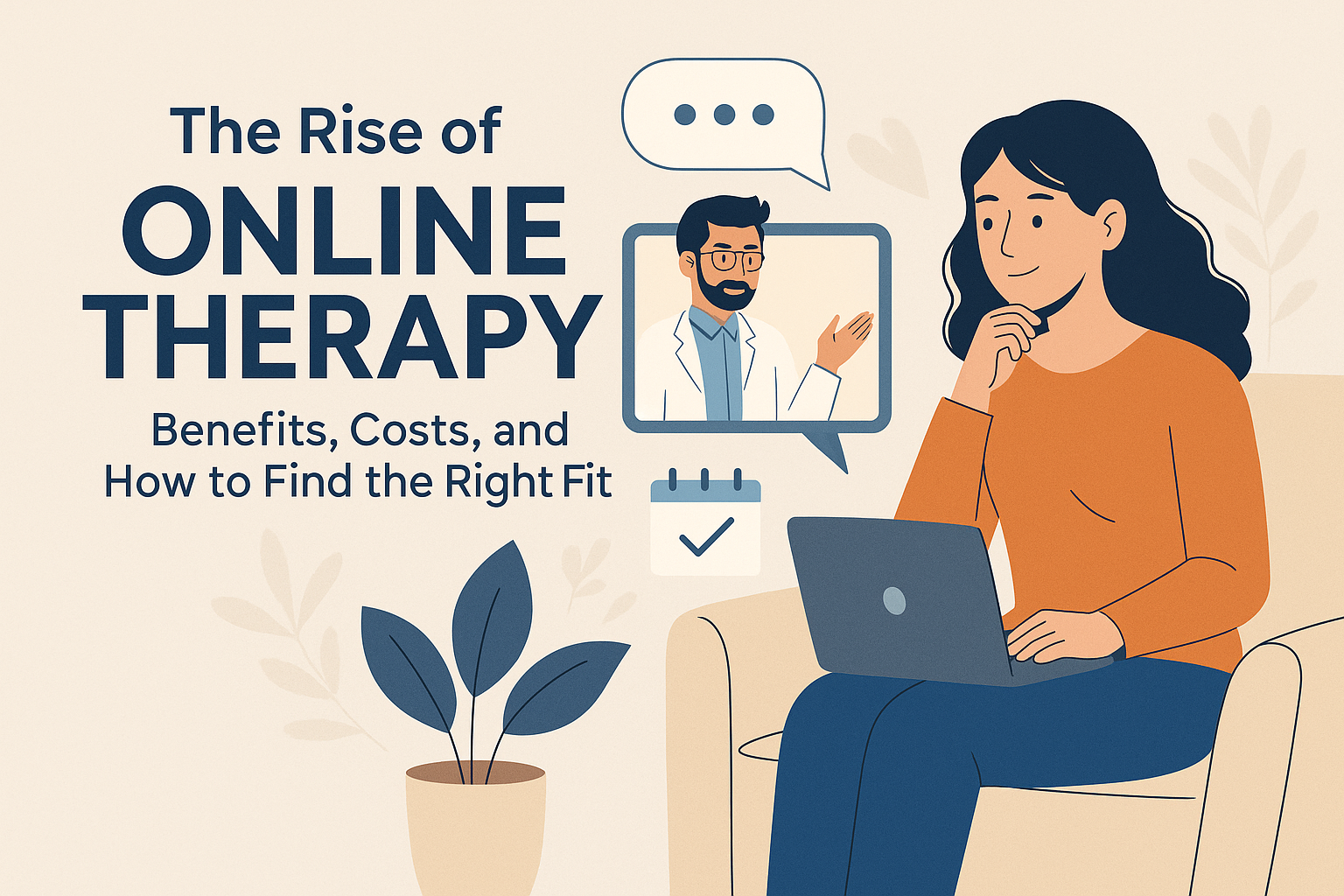Not long ago, therapy meant driving across town, waiting in a quiet lobby, then sitting across from a counselor in their office. Things look different now. The pandemic pushed care online, and people stuck with it, not just because it was necessary, but because it worked.
FAIR Health reported that between January and June 2024, mental health conditions were the top reason for telehealth visits across every U.S. region. That says something: Online therapy is now mainstream.
This article looks at what makes online sessions different, the pros and cons, what they cost, and how to choose a provider. If you’re new to therapy or just curious about online counseling, consider this your guide.
What Makes Online Therapy Different From Traditional Counseling
At its simplest, teletherapy means connecting with a licensed provider through video, phone, or even secure chat. The basics don’t change. You’re still talking to a real professional about real issues, but the format feels different.
Traditional therapy has a quiet room, body language cues, and sometimes even the ritual of the drive there and back. Online sessions strip that away. They give you the choice to log in from your kitchen table, a parked car, or your bedroom. For some, that’s freedom. For others, it might feel a little odd.
And yet, people are using it. In Colorado’s statewide data, behavioral health telehealth averaged about 35 visits per 1,000 people every month in 2024. Nationwide, mental health is the top telehealth service.
Can It Rival In-Person?
Skeptics ask the obvious question: Does talking on a screen work as well as being in the room? The research says yes, mostly.
A 2024 review looked at 35 randomized trials covering 4,827 people. The finding showed that online interventions worked about as well as in-person therapy for common conditions like anxiety and depression. The only downside was a slightly higher dropout rate. More people ghosted their therapist when the sessions were virtual.
Other studies back this up. A trial comparing outpatient and partial hospitalization programs showed no difference in symptom improvement between in-person and telehealth. Another JAMA Network Open study found that veterans using remote care saw both better access and better outcomes, especially those in rural areas where therapists are few and far between.
There are caveats. A JMIR Mental Health report warned that when facilities lean too heavily on virtual care, it can affect integration with other in-person services. Still, taken together, the data support online therapy as a legitimate, effective option.
The Benefits of Online Therapy
The rise of virtual care isn’t just about convenience, though that’s a big part of it. Other benefits are discussed below.
Convenience and Accessibility
Skipping a commute is more than a time-saver. It also makes therapy possible for people who live hours away from the nearest clinic or who can’t leave work easily. For someone juggling kids, classes, or shift work, that accessibility can be the deciding factor.
Privacy and Comfort
Not everyone wants to walk into a therapist’s office in a small town. Some people open up more when they’re in their own space, without worrying about running into a neighbor in the waiting room.
Consistency and Flexibility
When therapy is one click away, people are less likely to skip sessions. Consistency matters, especially for conditions like depression or PTSD. Online access helps people stick with the process.
Online Therapy for Teens
For adolescents, the barriers are even steeper. Teens often resist traditional care because they don’t want to be seen going into an office.
Studies show teens with depression or anxiety are more likely to choose telehealth for the convenience and the sense of privacy it gives them. For parents, that makes online therapy for teens an option worth considering.
The Limitations to Keep in Mind
No approach is perfect, and online counseling has limits you should know before diving in.
Insurance Coverage
Medicare made behavioral health teletherapy permanently available at home, which is a big win. But commercial plans vary. Some states require equal payment for telehealth and in-person visits, while others leave it up to insurers.
Therapist Availability
Demand is high, especially for specialists in trauma, postpartum mental health, or child psychology. Wait times can stretch weeks, even online.
Clinical Fit
Certain assessments, crisis interventions, or detailed psychological tests don’t translate well over video. Those still need in-person visits.
Equity and Access
Not everyone benefits equally. A Johns Hopkins study found patients from wealthier neighborhoods were far more likely to use telehealth for mental health compared to those from lower-income areas.
Online Therapy Costs and Coverage
The question most people ask is: What does this actually cost?
Medicare and Medicaid
Medicare permanently covers behavioral health teletherapy at home, with the same cost-sharing as in-person care. Non-behavioral telehealth services are covered only until September 2025.
Commercial and Employer Plans
Most employer plans include telehealth now, but how much you pay varies. Some charge the same copay as in-person sessions. Others apply deductibles or higher coinsurance.
Out-of-Pocket Costs
If you’re paying cash, prices vary a lot. FAIR Health Consumer lets you look up typical charges for therapy codes like 90834 or 90837 delivered virtually. That tool is one of the best ways to see if a provider’s rates qualify as affordable online therapy in your area.
How to Choose the Right Platform or Therapist
Picking the right provider can feel overwhelming. Here’s a checklist to make it easier:
- Make sure your therapist is licensed in your state and trained in telehealth.
- Call your insurer and ask about teletherapy coverage, including in-network rules and out-of-pocket costs.
- Ask platforms about encryption and privacy protections.
- Think about your comfort level: Do you want video calls, phone sessions, or messaging?
- If it’s for a teen, ask about consent rules, crisis protocols, and how caregivers are involved.
- Test the platform with a consultation to see if the tech works and if you connect with the therapist.
- Ask how emergencies are handled and when in-person care would be recommended.
Bringing Therapy Into Your Life, On Your Terms
The rise of online therapy proves that mental health care doesn’t need to look like it always has. For some, the convenience and privacy make all the difference. For others, in-person sessions will always feel better.
There’s no perfect roadmap. Some people will thrive with virtual care. Others will prefer the face-to-face setting. What matters is finding support that fits your life.
At Zeam Health & Wellness, our mental health clinics in Sacramento, Folsom, and Roseville offer both online and in-person counseling, tailored to your needs. If you’re ready to explore your options, reach out today.
Key Takeaways with Citations
- Online therapy is now mainstream. FAIR Health reported that mental health conditions were the top reason for telehealth visits across every U.S. region in early 2024【fairhealth†source】.
- Effectiveness rivals in-person care. A 2024 meta-analysis of 35 randomized trials found online therapy to be as effective as face-to-face sessions for conditions like depression and anxiety, though dropout rates were slightly higher【medrxiv†source】.
- Telehealth demand is sustained. In Colorado, behavioral telehealth visits averaged 35 per 1,000 people monthly in 2024, showing ongoing high use【civhc†source】.
- Teens benefit significantly. Research shows adolescents with anxiety and depression often prefer teletherapy for its privacy and accessibility【pmc8595951†source】.
- Equity gaps remain. Studies indicate wealthier patients are more likely to use teletherapy, raising concerns about access in lower-income populations【jamanetworkopen†source】.
- Coverage varies. Medicare permanently covers behavioral teletherapy, but commercial insurance and Medicaid policies differ, making cost research essential【fairhealth†source】.
- Out-of-pocket costs fluctuate. FAIR Health Consumer’s tool helps estimate typical charges for teletherapy sessions, making it easier to find affordable providers【fairhealth†source】.
- Privacy and consistency are major advantages. Patients appreciate not having to commute, the ability to attend sessions privately, and greater consistency in care【mental.jmir†source】.
- Limits exist. Crisis intervention, psychological testing, and some assessments still require in-person visits【pmc11954557†source】.




